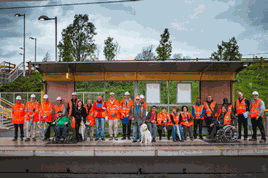TfGM organises meetings where DDRG members meet with project managers, architects, planners and other stakeholders to discuss any projects that may require their involvement. While the group was initially concentrating on the development of Metrolink, it now also consults on other aspects of public transport in Greater Manchester, such as the construction of new bus interchanges.
Over the past five years, during its £1.5 billion Phase 3 expansion programme, Manchester’s Metrolink tram system has grown significantly. This has included the construction of several new lines across the 57-mile network, with 57 new station stops built.
The DDRG has been actively involved in the design of these new tram stops. All stops are provided with access ramps or lifts, tactile paving, high visibility handrails, disabled boarding points and help points on the platforms. And while most of the new tram stops themselves have reasonably standard designs, the ease of access to the stops has been carefully considered in relation to the geography of the surrounding area.
Once built, and prior to any new line being brought into use, TfGM invites the DDRG to travel by tram to the new station stops, to ensure that all of the station stops are suitable for disabled passengers.
DDRG Facilitator Andy Walker is a wheelchair user. He explains: “Over the past few years we’ve seen dozens of new Metrolink stops opening. Our group has had the opportunity to make sure each and every one of them will meet the needs of people with a range of impairments. The visits take place as the line enters the final stage of a thorough pre-launch process.”
TfGM has also carried out a modernisation programme at all of the older Phase 1 and Phase 2 tram stops, including a major rebuilding of Victoria, St Peters Square and Deansgate-Castlefield station stops in Manchester city centre. All changes to the design of these stops have involved consultation with the DDRG.
And when TfGM was looking to install some additional seating in newer batches of the M5000 trams, the needs of disabled tram users were taken into account. Again, the DDRG was consulted about the changes that were being proposed.
The M5000 fleet will eventually feature 120 units. Trams numbered 3001-3074 were all delivered with 60 seats, but with large areas available for standing passengers, along with areas for the provision of wheelchairs and pushchairs.
However, a frequent comment made about the trams was that there were not enough seats on the M5000s. TfGM therefore decided to try to modify the seating layouts in trams delivered from 3075 onwards, to provide some additional seats without compromising the needs of those passengers who used wheelchairs.
Modified seating configurations were installed inside tram 3024 on a temporary basis, and the DDRG was asked to view the modified tram and travel on it, to give its opinions on how the changes would affect disabled users. After consultation, a new seating layout was agreed for the newer tram orders, providing another six seats on each tram, and 3024 was returned to its standard seating arrangement. Whether the first 74 trams are subsequently modified when the trams come due for refurbishment remains to be seen.
In 2013, the DDRG was responsible for producing a Metrolink Access Guide that supports disabled passengers, allowing them to plan their journeys and giving them relevant information about access arrangements at station stops.
The approach taken by TfGM in developing the DDRG is now recognised as a model of best practice by the Equality and Human Rights Commission.
TfGM Metrolink Director Peter Cushing said: “We’re particularly proud of the work we’ve done with the Disability Design Reference Group to help make Metrolink the most accessible transport system in the region.
“They’ve made an invaluable input to every extension we’ve opened in recent years and I thank them for taking the time to help improve the network for people across Greater Manchester.”
The days when people with disabilities were discouraged from using public transport are now thankfully long in the past. And it is clear that TfGM is determined to do whatever it can to make Metrolink and other forms of public transport an attractive and welcoming experience for everyone.
- This feature was published in RAIL 788 on November 25 2015















Login to comment
Comments
No comments have been made yet.